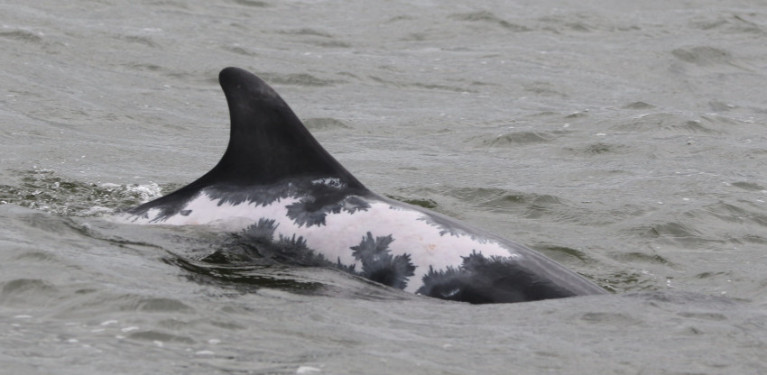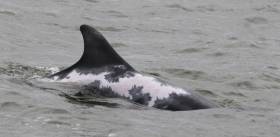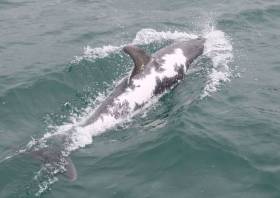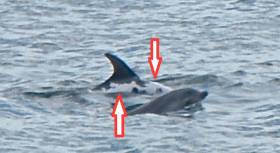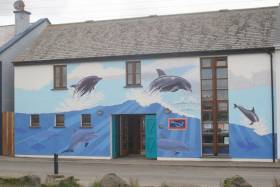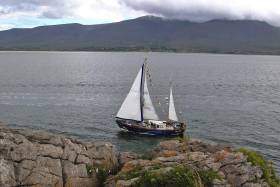Displaying items by tag: bottlenose dolphins
Researchers Use Drones to Detect Dolphin Pregnancies
Pregnancies in bottlenose dolphins can now be determined from images captured by drone, according to new research.
As the Irish Examiner reports, marine scientists from University of Aberdeen and Duke University have flown drones over the Moray Firth Special Area of Conservation in Scotland to collect overhead images of dolphin pods.
From these, the researchers believe that by measuring the body width of this protected marine wildlife species, they can determine which dolphins may be with calf.
“Previously, we only knew if female bottlenose dolphins were pregnant if they were later seen with a calf,” said Dr Barbara Cheney of the University of Aberdeen.
“As a result, we only knew about successful pregnancies, and didn’t know how many pregnancies failed or how many calves died before we saw them.”
The Irish Examiner has much more on the story HERE.
Excited to share our research using aerial photos to measure length and width of known bottlenose dolphins, and determine pregnancy status ➡️ https://t.co/TyifGXCO84@NicolaJQuick @MarineUAS @RSECJournal @UoABioSci @aberdeenuni https://t.co/Q9lN29By0f pic.twitter.com/FRGkFCJrsJ
— Lighthouse Field Stn (@CromartyLH) February 14, 2022
Dusty the dolphin last weekend treated two SCUBA diving sisters to an encounter they will never forget, as RTÉ News reports.
Jessica and Jennifer Smith were diving with their father Finbar as part of a group with the Burren Sub Aqua Club last Saturday (1 May) when they were approached by the inquisitive bottlenose, who has been a fixture of the West Clare coast for some 20 years.
Previous encounters have been mixed — in particular an incident reported in Doolin some years ago in which a woman was hospitalised.
But the teens were delighted to meet a much calmer Dusty, who may have been surprised to find humans in the water after months of restrictions prevented group dives.
RTÉ News has more on the story HERE.
Miracle dolphin Spirtle has returned to her home waters in the north-east of Scotland after her summer spent off Ireland’s south-west coast, as BBC News reports.
The bottlenose dolphin with a distinctive sunburn scar was spotted with her family group in the Moray Firth this past Tuesday (17 December) — four months and hundreds of miles away from their last sightings in the waters off Co Kerry.
Spirtle initially surprised marine wildlife experts when she survived a live stranding ordeal in 2016 in which she suffered severe sunburn — and again this past summer when she and a number of her group were tracked heading south from Scotland through the Irish Sea.
A spokesperson for Whale and Dolphin Conservation said 2019 “has been a very unusual year for this dolphin population’s movements around the UK and overseas to the Dutch coast — it might not be quite finished yet”.
In other news, the Irish Whale and Dolphin Group (IWDG) says competition for food “seems to be growing more intense” for fin whales in the waters off Co Waterford, who made a more fleeting visit than usual for this time of year.
More Sightings Off Kerry Of Miracle Dolphin ‘Spirtle’
Marine wildlife miracle Spirtle appears to have taken up residence off the Kerry coast if the many sightings over recent weeks are anything to go by.
Last month the young dolphin was spotted in the area some weeks after she was seen off the East Coast, headed south from her usual haunt off the west of Scotland.
Indeed, it was there where she live stranded in 2016 and suffered severe sunburn, which left her with her distinctive markings.
Despite fears that she wouldn’t survive her ordeal, Spirtle returned to fine health and is now part of a small pod regularly feeding off Feit in Tralee Bay, and which includes a juvenile, according to the Irish Whale and Dolphin Group (IWDG).
Researchers are now trying to establish if Spirtle became part of this group after her long travels, or whether they swam with her from Scotland.
Initial evidence suggests at least two of her pod are Scottish regulars, including Spirtle’s own mother Porridge.
“We have documented movements of individual bottlenose dolphins between Ireland and Scotland before, but we do not know how often this occurs or whether it is typical behaviour,” the IWDG said.
“We hope to continue to monitor the presence of this famous ‘Scottish’ dolphin and see if she stays or travels further,” the group added.
Spirtle The Dolphin In High Spirits Off Kerry
Nearly two months after she was spotted off the East Coast, Spirtle the dolphin has been filmed frolicking off the shores of Kerry, as the Irish Mirror reports.
The young dolphin is distinctive for the heavy scarring and discolouration on her right flank — caused by severe sunburn wen she live stranded on a Scottish beach in 2016.
Having bounced back from that brush with death, her wounds gradually healing over the years, Spirtle was recently sighted at the lead of a group of bottlenose dolphins that was making its way south along the Irish Sea.
Marine wildlife experts are now trying to establish if this pod has now made it to the Kingdom, as Spirtle was caught on camera by Dr Joanne O’Brien in recent days with around 20 other bottlenose dolphins in Tralee and Brandon bays.
There is no word as yet on whether Spirtle and her colleagues paid a visit to Dingle’s longtime resident dolphin, Fungie.
Sightings of an unusual looking bottlenose dolphin off the East Coast in recent weeks have turned out to be a Scottish scrapper named Spirtle.
Images of the dolphin seen off South Dublin and North Wicklow earlier this month showed what appeared to be heavy scarring and discolouration on its right flank.
That was enough for Dr Joanne O’Brien of the Irish Whale and Dolphin Group (IWDG) to identify the animal as the daughter of a dolphin well known in the Moray Firth.
Spirtle’s story is one of survival as almost three years ago to this day, she was found live stranded with significant injuries and suffering severe dehydration.
Since then she’s bounced right back from the brink of death, and it appears she’s now even at the lead of a group of bottlenose dolphins that’s made its way south along the Irish Sea beyond Dublin Bay.
A rare sighting of a different kind was made in West Cork this past week, where a charter boat operator witnessed what he believed was an attack on a pod of common dolphins by a killer whale.
David Edwards was 15 miles south of Galley Head last Tuesday (21 May) when he saw the orca chase after its fellow cetaceans for its lunch — and his images of the event have been confirmed by IWDG sightings officer Padraig Whooley.
Echo Live has more on the story HERE.
IWDG Requires Bottlenose Dolphin Research Assistants For The Shannon Estuary
#MarineScience - The Irish Whale and Dolphin Group’s Shannon Dolphin Project is seeking research assistants from May-September 2018 based in Kilrush, Co Clare.
Research assistants will be required to conduct monitoring surveys from dolphin-watching tour boats, spend a considerable amount of time on Shannon Estuary bottlenose dolphin photo identification and related office tasks, and assist in the management of the dolphin centre on a daily basis.
Photo ID training will be provided on the boats and in the office. There will also be the opportunity to help with research conducted on board the IWDG’s research vessels Muc Mhara and Celtic Mist, and to assist the IWDG with cetacean strandings should the opportunity arise.
These positions provide an excellent opportunity to develop skills in marine research and education and to assist with one of the longest-running bottlenose dolphin population monitoring programs in Europe.
There is no monetary compensation for these positions and a contribution of €400 per month towards accommodation and utilities is required.
Volunteers will be expected to work and live as part of a team with shared cooking and cleaning duties. Accommodation will be provided in a shared house within walking distance of the dolphin centre and town of Kilrush. Research assistants are responsible for their own food costs and travel expenses to and from Kilrush.
The closing date for applications is Friday 30 March. However, early application is recommended. Shortlisted candidates will be required to undertake a Skype interview in April. Successful applicants will be notified by mid-April.
Full details on the positions can be found on the IWDG website HERE.
Protections Called For Shannon Dolphins In North Kerry
#MarineWildlife - Conservationists want Tralee Bay and Brandon Bay in North Kerry to be declared a protected marine wildlife zone for bottlenose dolphins.
The call comes in the wake of new research by the Irish Whale Dolphin Group (IWDG) in tandem with the Shannon Dolphin and Wildlife Foundation, which has identified the vast majority of bottlenose dolphins in North Kerry as members of the Shannon Estuary group that has enjoyed Marine Protected Area status since 2000.
“We knew dolphins had been regularly observed in Brandon Bay,” said the IWDG’s Dr Simon Berrow of the new research, “but did not know which population they belonged to and had no idea they were as abundant and frequent as this study has shown.”
Stephanie Levesque, senior author of the study, added that the research identified “very high numbers of Shannon dolphins present during the summer months in Brandon and Tralee Bays.
“If further surveys were to be carried out at various times of the year, including collecting behavioural data, it could help us to better understand how they are using these habitats.”
Elsewhere on the West Coast, Galway Bay FM reports on efforts in Connemara to form local groups in Oughterard and Letterfrack which are designated for the protection of pearl mussels.
Shannon's First Recorded Dolphin Spotted Again 20 Years On
#MarineWildlife - The 21st year of dolphin research in the Shannon Estuary is off to an amazing start after the first ever dolphin recorded in the estuary was spotted on the Kerry coast.
As the Shannon Dolphin and Wildlife Foundation (SDWF) reports, the dolphin known as 'No 1' was sighted in Brandon Bay on Saturday 25 May swimming in a group of three.
No 1 is happily a familiar sight in the region, having been recorded most years since the project began in 1993.
"It has long been known that Shannon dolphins regularly use Tralee and Brandon Bays but how important the area is in not clear," says the SDWF on its blog. "If we are to protect the Shannon dolphins we need to ensure we identify all their important habitats and extend protection to these areas if necessary."
Meanwhile, its been confirmed that the trio of bottlenose dolphins who took up residence near Bunratty Castle in the spring have been observed in the mainstream of the Shannon Estuary.
The three were spotted on the first monitoring trip of the summer from Kilrush last week by SDWF researchers of Moneypoint.
"This demonstrates again the value of long term monitoring and the power of a photo ID catalogue to monitor the Shannon dolphins," says the SDWF blog.
In other cetacean news, an in-depth discussion of the Shannon's dolphins and the Irish Whale and Dolphin Group's (IWDG) research of bottlenose dolphins around the Irish coastline was broadcast on Derek Mooney's afternoon show on RTÉ Radio 1 recently.
A podcast of the 30-minute segment of Mooney Goes Wild from Friday 31 May is available to download HERE.
Dolphin Group Comments on Dalkey Island Prospect
#DALKEY ISLAND PROSPECT - The Irish Whale and Dolphin Group (IWDG) has joined the chorus of opposition to the proposed oil and gas exploration off Dalkey Island in Co Dublin.
As previously reported on Afloat.ie, Providence Resources has applied for a foreshore licence to search for oil or gas about 6km out to sea on the Kish Bank Basin.
But the prospect has provoked a split in the local community over the potential risks and benefits, with many calling for a public enquiry into the licence before it is granted.
This evening an urgent meeting in Dun Laoghaire will address the public's concerns, which have been echoed by the IWDG.
"The Kish Bank and adjacent waters are important for cetaceans," said the group in a statement. "In addition, sightings of bottlenose dolphins have increased dramatically in the area following the presence of a group of three individuals since August 2010."
The IWDG is concerned about the potential effects on dolphins and porpoises that "could due to noise generated from the drilling process", noting that "there is little published data on the intensity and effects of sound generated by drilling".
Protest group Protect Our Coast has launched a online petition against the Dalkey Island Prospect citing concerns over the proximity of the drilling area to the mainland as well as the Special Protection Area of Dalkey Island, which is a haven for marine wildlife.
- Irish Whale and Dolphin Group
- IWDG
- Dalkey Island Prospect
- Coastal Notes
- Dalkey Island
- Dublin
- oil and gas
- exploration
- drilling
- Providence Resources
- foreshore licence
- Kish Bank Basin
- community
- Dun Laoghaire
- bottlenose dolphins
- Porpoises
- Cetaceans
- noise
- sound
- Protect Our Coast
- protest
- petition
- Special Protection Area
- marine wildlife



























